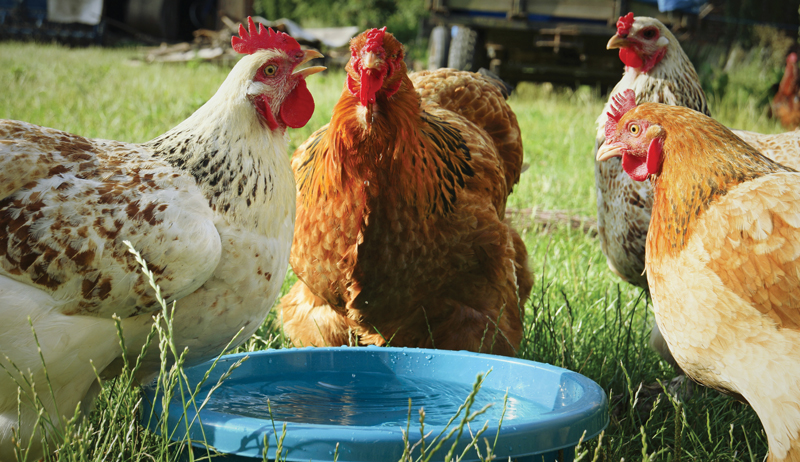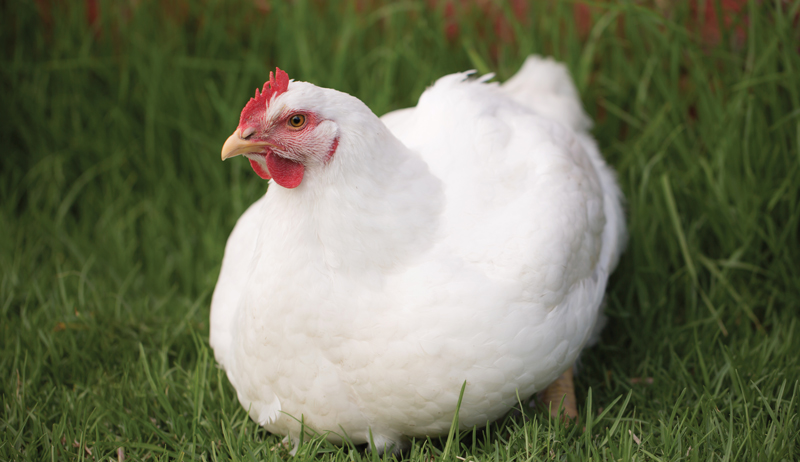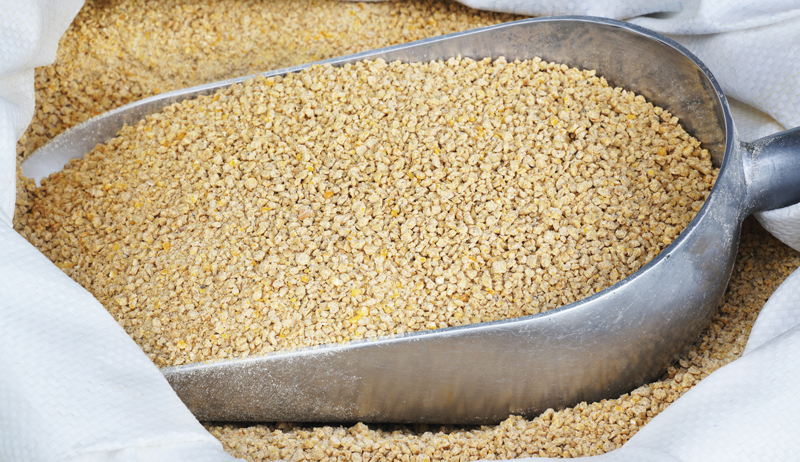
Everyone who keeps chickens should have a simple knowledge of nutrition and how what we put into our hens or meat birds impacts their health, longevity and levels of production. It should be noted that volumes have been written about nutrients, animal rations and general feeding practices. Here, we’re going to stick with the basics.
For this overview, we’ll glimpse all six classes of nutrients. Each grouping is related, and they interact metabolically to help maintain the health of chickens.
Each category also has members within the class that are essential nutrients.
Essential nutrients are specific molecules within a morsel of food that absolutely must be ingested by the animal. For a hen, it’s some kind of molecule that she can’t produce on her own. She must eat it.
A perfect example is water. A chicken can’t produce water and yet a chicken—or any other animal—must drink water! Therefore, like other nutrients, is essential. It’s one of the reasons scientists look for water in outer space: If there is no water, there is no life as we know it.
Check out this no-mess chicken watering and feeding system!
Water
So, water is our first example of the essential nutrients. It is also a stand-alone nutrient. Water must be given to all animals free-choice. In other words, clean water must be available at all times. When chickens and other animals wake in the morning, they’ll need water fairly soon.
The amount of water they consume will also affect the amount of food they eat and even their mood and stress level.
Even though chickens don’t have sweat glands, they do lose water in other ways. Most moisture or water loss occurs when they defecate. Even more is lost just because of breathing.
Obviously, death could occur quickly if the coop runs out of water! Never deprive your hens by filling a bowl at your convenience.
Use automatic waterers or nozzles to provide a constant source of water, if possible. And make sure it doesn’t clog or freeze.
In addition to helping the flock maintain body temperature, water is related to every metabolic activity in a bird’s body. Because there is water within the cells, blood and bones, chickens must maintain between 65 to 70 percent water by weight.
Carbs
The second group of nutrients adds just one more element to the water molecule. Water is made up of oxygen and hydrogen. Adding carbon makes the appropriately named nutrient: carbohydrates.
One of the simplest of carbs is the sugar molecule known as glucose. Basically, plants can use carbon dioxide from the air, moisture from the soil and energy from the sun to create glucose. We know this as photosynthesis.
Plants take it a step further to create different forms of sugar, starches, hemicellulose and cellulose.
As carbs become more complex during plant development, they become more difficult to digest. Once plants go to seed, most carbs are stored in the seed to provide a food source for the new plant.
So it’s pretty obvious that grains provide an excellent source of carbohydrates. Seeds most common in scratch are corn, milo (sorghum), wheat and barley.
Other sources might include oats, sunflower seed and others. Grains basically come from grasslike plants and not broadleaf plants such as beans.
Chickens reverse the process of stored energy that came from the sun. That means: As the chicken eats grain, it burns carbon, generating heat energy.
The hen exhales carbon dioxide the plant originally stored, and energy released provides body temperature and energy for mobility.
For chickens, grain is a snacklike treat. They will eat too much. The problem here is that scratch generates energy but lacks sufficient protein for growth or egg production.
I like to throw grains directly on the ground and let the chickens “scratch” for it. If there’s any left in 15 minutes, you’re feeding too much.
Never feed scratch free-choice. To do so gives hens too much starch and not enough of the other nutrients, especially protein.
Here are 5 sources of alternative protein for chicken flocks.
Protein
Protein is yet another nutrient that has carbon, hydrogen and oxygen. The big difference is protein also contains nitrogen.
For most animals, including your chickens, there are 10 essential proteins, nutrients known as amino acids. They are the building blocks for muscle and organ tissue. There are more than 10, but only 10 that the chicken can’t make all by itself by breaking down and combining other amino acids.
Those 10 nutrients are therefore essential for the chicken to eat.
Here’s a little anecdotal information to help understand amino acids. As a chick grows, it creates its own muscle tissue.
Now try to look at the muscle tissue as if you were building a brick wall with different colored bricks. It’s weird, right? Remember, they’re called building blocks.
Building a Chicken
A chicken’s drumstick is made up of a very specific group of amino acids. Think of amino acids as bricks.
If you had to build a wall and every tenth brick had to be a yellow brick, the size of your wall would be limited by the number of yellow bricks you have. In this situation, once you run out of yellow bricks, you have to stop building your wall.
It’s the same with amino acids. If one of the 10 amino acids is too low, it will slow down or limit the growth of the chick’s tissue.
Usually the two amino acids that are low in chicken feed are lysine and methionine. Read the label on many feedbags, and those two amino acids should be listed.
For instance, the bag analysis may say “minimum lysine … 0.75%” or “minimum methionine … 0.35%.” Trusted feed companies not only know which amino acids are needed for a complete diet, they also know the quantity of specific amino acids needed to constitute a balanced diet.
Laying hens should receive at least 16 percent protein. Growing chicks and meat birds should have a diet with 20 percent crude protein.
Read labels and buy from trusted sources.
Black fly larva: A self-harvesting chicken feed.
Meal Worms
If you want to add protein to a chicken’s diet, think about an animal protein like mealworms. Dried mealworms are usually more than 50 percent protein. It’s a reliable protein supplement, and chickens love them.
No need to overdo it. Remember, worms are also a treat and would be costly if you were to feed them as a major part of the ration.
I raise my own mealworms and feed live ones to my hens. Because live worms aren’t dried, they contain moisture and are lower in protein by weight.
Live worms are a natural feed for chickens since they are omnivores. I often get a kick out of the wording on supermarket eggs. Some labels say, “From chickens fed a vegetarian diet.” Chickens are not herbivores!
Your flock loves to eat bugs and worms. That’s a food source loaded with protein. Free-range wins again!
Fat
You might not consider fat as an essential part of a chicken’s ration. Nevertheless, the truth is that fats and oils are present in most plants.
Flax seed oil, sunflower oil, corn oil: all terms that prove plants contain fats and oils.
Two main fats are, indeed, essential nutrients—specifically, omega-3s and omega-6s.
Fats are solid at room temperature like a cube of butter, and oils are liquid at those temperatures. Both essential fats can be used by the body as energy sources, and both nutrients are used by the chicken to transport fat-soluble vitamins.
Fats and oils affect the palatability or taste of the chicken’s ration.
One word of caution: Fats stored at room temperatures eventually turn rancid. It’s one reason you should not store feed for extended periods.
Only buy enough feed to last a few months at most. Even though fat levels may be low, certain feeds can turn rancid.
Fats are often associated with cholesterol. Omega-3s and omega-6s are the so-called good fats, and eggs moderately infused with these fats are a healthy product for human consumption.
The fats that can cause trouble are trans fats and saturated fats.
Fats provide more than twice the energy of carbohydrates and are often referred to as brain food, because the chicken’s brain (and our own) is largely composed of cholesterol-filled cells.
Vitamins
There are two classes of vitamins, although more than 10 of these nutrients are essential. The two main groupings are water soluble and fat soluble.
Water soluble vitamins are B complex vitamins and vitamin C. Poultry, unlike humans, can make or synthesize their own vitamin C. Additionally, most of the B vitamins are readily available from plant sources.
The one exception is vitamin B-12 which, chickens can source from the microbes that live in their gut or from the worms and bugs they consume. Chick starter feed often has a vitamin boost because chicks really don’t have microbes in their system for the first few days.
They also struggle briefly producing enough vitamin C.
Fat-soluble vitamins are vitamins A, D, E and vitamin K. Vitamin D can be produced by poultry through a specialized process in the skin if the chicken has exposure to sunlight. Vitamins A and E can be found in plants and are therefore ingested by chickens daily.
Some plants are high in carotene (vitamin A), and these plants will often promote richly colored deep yellow-orange egg yolks.
Chickens and other species produce vitamin K to help coagulate blood in case of an injury. Many poisons for rodents use a vitamin K inhibitor, causing internal bleeding in the rodent.
You may notice that free-range chickens produce dark, rich yolks. Given the opportunity, hens will eat grains, grasses and bugs that fill their needs.
Eggs from free-range hens are loaded with good fats and with heavy doses of plant-sourced vitamins.
Is free-ranging better for chickens?
Minerals
The minerals a chicken needs to survive are all essential nutrients. Your hens can’t produce carbon, phosphorus, potassium or any other mineral.
Gold is a mineral, and let’s face it: There is no goose that can lay a golden egg! Simply put, minerals must be consumed.
Bone and shells are composed mostly of calcium and phosphorus, so your flock needs those two in fairly high levels. Fortunately, grasses and other plants have enough to supply their needs. Nevertheless, most producers provide oyster shells and grit supplements to ensure adequate calcium.
The minerals needed by your flock in moderately high doses are known as macro-minerals. If just trace amounts are needed, they are called micro-minerals. Iodine, iron, boron and selenium are examples of micro-minerals.
Usually when a mineral is missing or insufficient in the ration, the chicken will at first display some kind of subclinical symptom. Sub-clinical means your flock is deficient, but the nutrient is not completely lacking.
However, if the deficiency continues or increases over time, the symptoms will worsen, and death will ultimately occur.
For example, if your flock is moderately low in the macro-mineral calcium, the first sign may be thin, weak eggshells. If the situation continues, production will suffer, bones may be noticeably deformed from chicken rickets and eventually death will occur.
If you have several hens all showing some kind of symptom, at least consider something might be lacking in their diet and consequently affecting them all.
Best Management
Keep this in mind with a flock of any size—best management practices always include buying feed from trusted sources. Also, make sure you allow some access to pasture, fresh air and the sun.
Never feed spoiled moldy rations. And provide ample clean, fresh water.
Your flock will reward you with nutritious eggs and meat for years to come!
This article originally appeared in the May/June issue of Chickens magazine.




